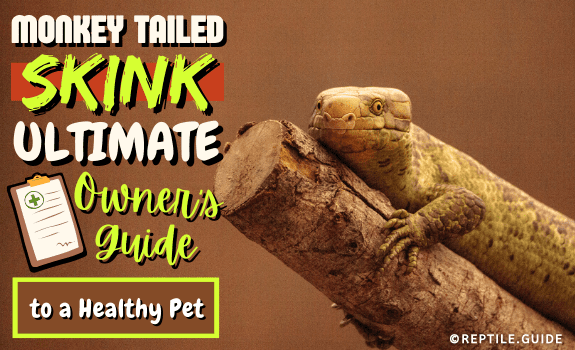Keeping monkey-tailed skinks as pets is an excellent idea if you don’t mind an animal that’s mostly for show.
Females only produce one baby monkey-tailed skink at a time (sometimes two), which makes it hard to produce many of them.
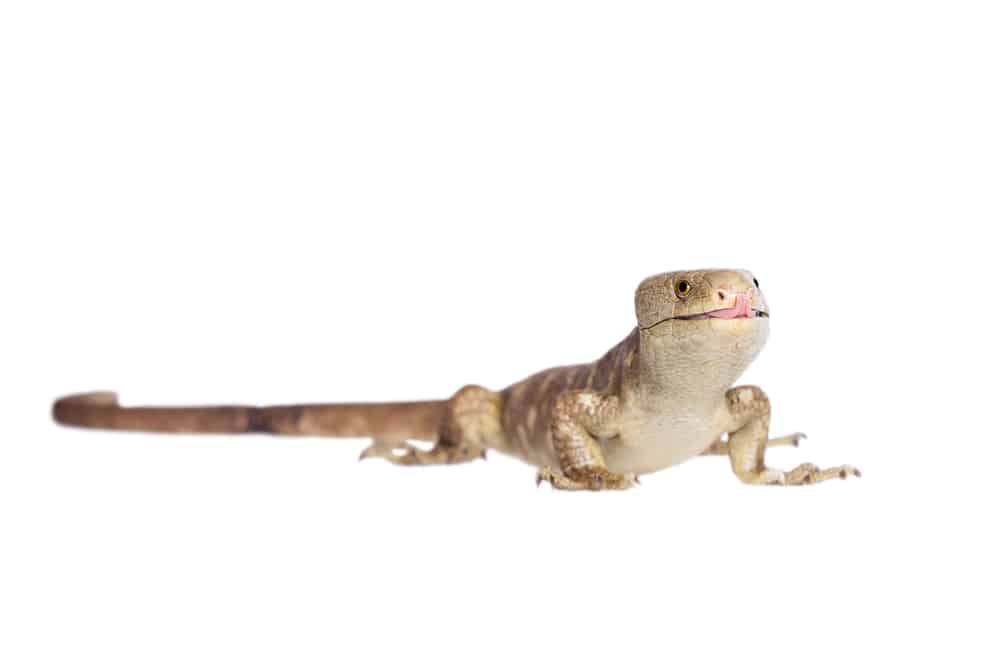
The monkey-tailed skink price is quite high (over $1300 for a small baby).
Let’s delve into the other details of monkey-tailed skink care.
In This Article
Monkey Tailed Skink Basics
The monkey-tailed skink, Corucia zebrata, also goes by the name prehensile-tailed skink, Solomon Islands skink, and a range of other monikers.
This lizard is the largest skink in the world, and endemic to the Solomon Island Peninsula. The island is in the Pacific Ocean, off the coast of Australia.
Wild populations are under threat from illegal exports and habitat encroachment, but not in immediate danger.
The monkey skink gets one of its names, prehensile-tailed skink, from its fascinating lifestyle.
Solomon Islands skinks are entirely arboreal and have adaptations to help them with that. These include:
- Sharp claws for gripping tree limbs
- A strong, prehensile tail which they can wind around branches and hang from
- Strong jaws for eating tough foliage
The monkey-tailed skink also gives birth to fully-functioning live young, giving babies a better chance at survival.
A fascinating attribute of the monkey-tailed skink is that it lives in a bonded social group called a circulus.
Are Monkey Tailed Skinks Good Pets?
These skinks are excellent pets for someone who likes having beautiful animals around and doesn’t mind not being able to handle them.
Solomon Islands skinks CAN be good pets, but that doesn’t mean they always ARE good pets.
The monkey-tailed skink is a large, slow-moving lizard which makes them easy to handle. Even so, these skinks often don’t take well to handling.
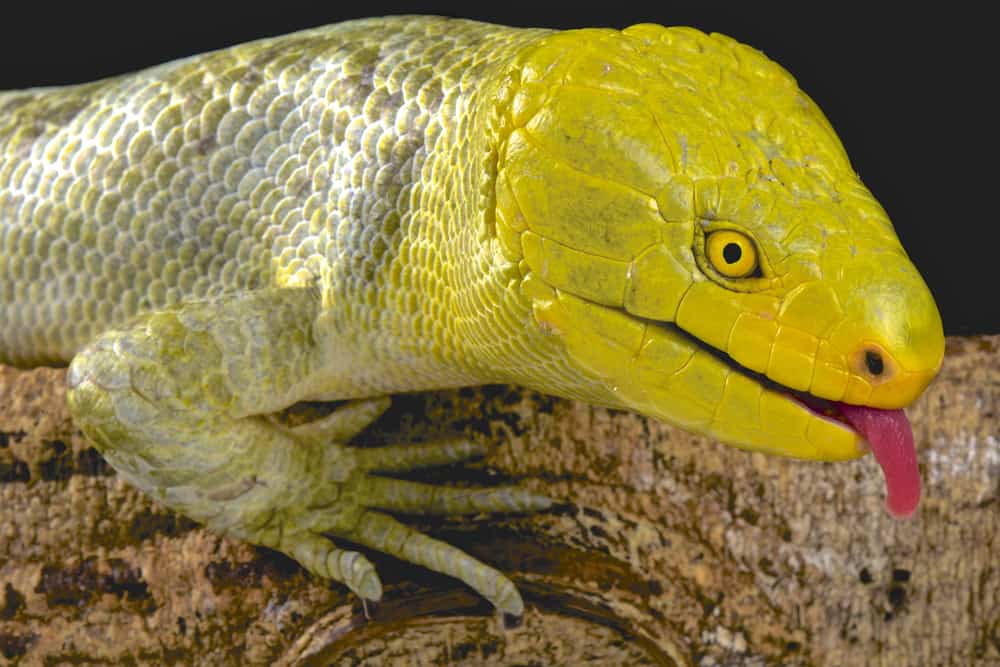
Large male skinks, in particular, can become quite territorial.
Facing down a large zebra skink with sharp claws and blade-like teeth is no joke.
In short, monkey-tailed skinks are good pets if:
- You can provide a large enough enclosure
- You socialize the skinks from a young age
- You handle them often, so they can learn to recognize you
- You have time to care for a small group of large lizards
- You don’t mind having display animals that are not fond of handling
Monkey-Tailed Skink Appearance
Monkey-tailed skinks are the largest skinks, reaching lengths of between 24 and 32 inches.
Even a new, small monkey-tailed skink is large (around half the length of the mother).
They have long bodies and short, barrel-like legs with razor-like claws at the end. This species has a sturdy prehensile tail which it uses like that of a monkey.
They wrap their tails around branches as an anchor, and may also hang from it at times.
Typically, Solomon Islands skinks vary in color from dark green to light brown or a dark green-brown. Their heads are often a different color (typically light yellow or light green).
What Do Monkey Tailed Skinks Eat?
The prehensile-tailed skink, Corucia zebrata, eats vegetation, including leaves, flowers, shoots, roots, and fruits.
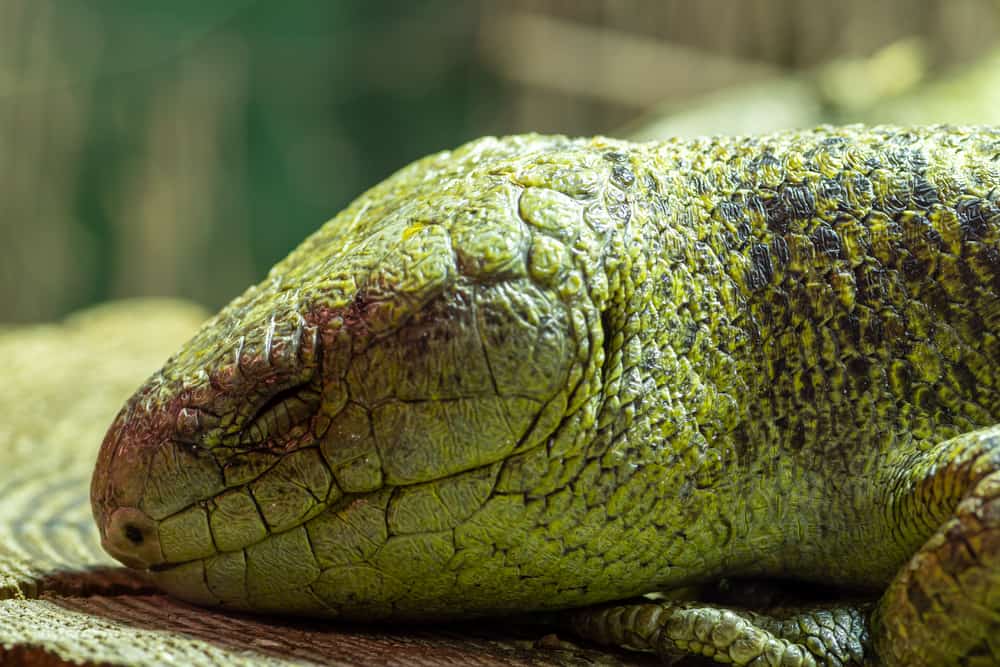
A monkey-tailed skink has all the attributes of a fantasy monster. They have razor-sharp claws, climb things, and have tiny daggers for teeth.
To most people, these things would indicate a voracious predator. However, the Solomon Islands skink has sharp teeth for tearing apart leaves, and claws for climbing.
Like most herbivorous lizards, these skinks will take any easy source of protein that comes their way.
From bird eggs to insects and dead animals, they’ll happily take a nibble of free protein.
The monkey-tailed skink doesn’t need a lot of animal protein. What it does need is a wide variety of plant materials.
In captivity, the following all make good food choices:
- Green beans (high in vegetable proteins)
- Leafy greens (like mustards and kales)
- Cooked sweet potato
- Fruit like kiwi and apple (as treats)
These animals need a calcium supplement and can benefit from a high-quality multivitamin.
Both are available in powder form, and you can sprinkle them over the skink’s food.
While these animals love fruits (which includes green beans), try to give those as an additive rather than a staple.
It’s okay to feed fruit around twice a week since it’s best to avoid large amounts of sugar when planning your skink’s diet.
Aim for more foliage and leafy greens than fruits.
The monkey-tailed skink is a capable plant-muncher and will even eat plants like Pothos which most things avoid eating.
Monkey Tailed Skink Enclosure
Many breeders in the pet trade prefer keeping large lizards like the monkey-tailed skink in outdoor enclosures.
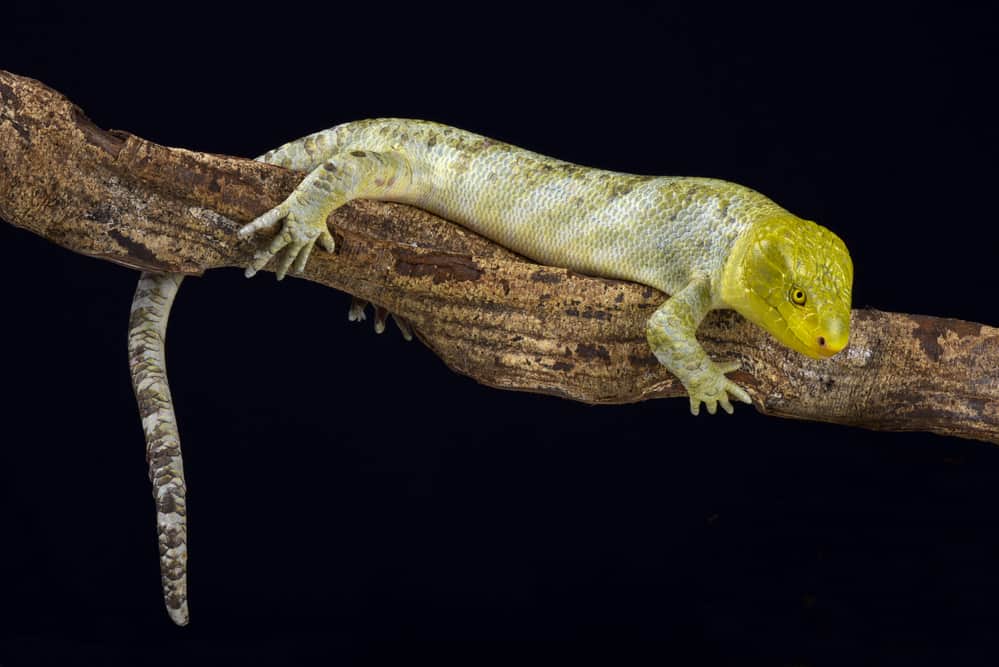
Since these animals come from a semi-tropical island in the Pacific Ocean, they have specific temperature needs.
If you can maintain an ambient temperature of 75-80 °F outdoors, you can easily build an outdoor monkey-tailed skink enclosure.
Outdoor enclosures usually consist of a wooden or metal support structure, with hardware cloth or welded mesh covering.
They should be out of danger from weather events like wind and rain and provide plenty of cover for the lizards.
Indoors, your enclosure options include:
- A converted IBC tote
- A large aquarium
- Custom-built plexiglass, plastic, or glass terrariums
- Wooden terrariums with ventilation and a glass viewing pane
Any non-toxic building material will do, as long as you can clean it and it has no sharp edges.
Monkey Tailed Skink Cage Size
Since these skinks are the largest species of skink and are relatively active, the monkey-tailed skink cage size should be quite large.
For a single specimen, you’ll need an enclosure that’s five feet high, three feet wide, and six feet long.
Pro Tip: If you truly want to experience the full glory of monkey-tailed skinks, you need at least a pair.
These reptiles live in family groups in the wild, so you can safely form a group of two to four skinks by raising them together.
Male skinks should make up the center of the group (no more than one) with two to three female skinks.
Not all hobbyists have equal success with this method, and if you see signs of stress on the females, you might have to remove the male.
Many people successfully keep pairs or small groups, and it varies based on the personalities of the lizards.
If you keep a family group, you’ll need an enclosure that’s around five feet high, five feet wide, and eight feet long.
Monkey Tailed Skink Cage Design
Monkey-tailed skinks are an arboreal species, and their cage should reflect that.
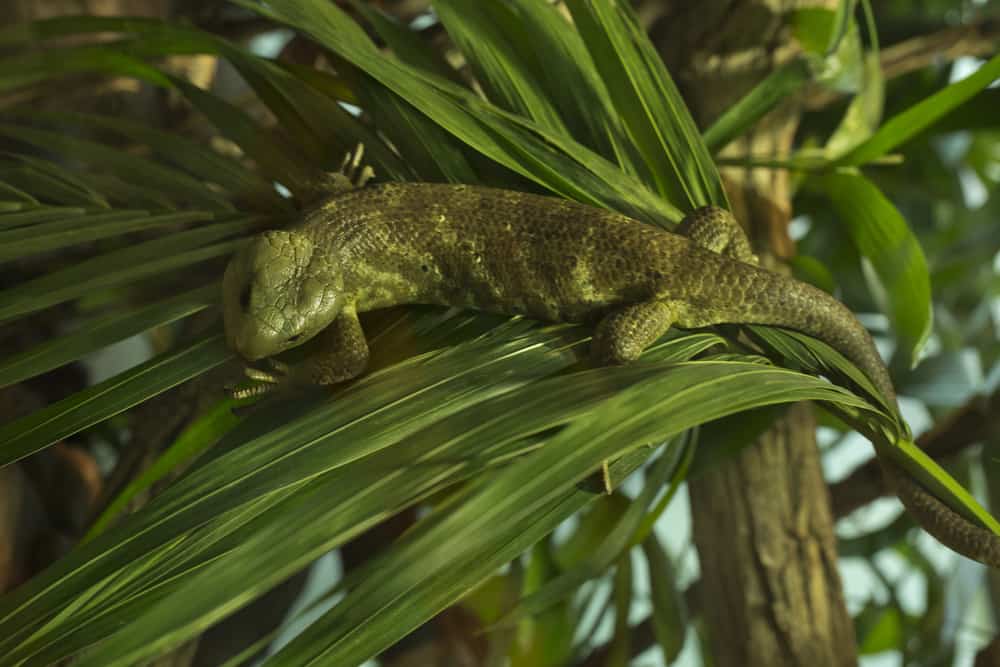
These reptiles must have plenty of space to climb. The prehensile tail needs anchors too.
We suggest placing many branches inside the enclosure. Climbing vines, live plants, and even natural-fiber ropes can all add climbing room to their enclosure.
Provide several hides distributed around the upper levels of the enclosure, since that’s where they prefer to rest.
Ensure that there’s at least one hide near the basking lamp, and another on the cool end.
An excellent option is placing a hide beneath the basking lamp so the lid can form a basking platform for the lizards.
A large water bowl is an essential element for prehensile-tailed skinks. It gives them a place to drink water and also helps to maintain the humidity in the enclosure.
If you’re keeping a family group of monkey-tailed skinks, try to give the enclosure as many climbing areas as possible.
This will give the female skinks room to evade the male (or each other) if the need arises.
Monkey Tailed Skink Heating
As with most reptiles, monkey-tailed skinks can’t control their body temperature. They control their body temperature by moving between warm and cool areas.
To accommodate this, you need to give their enclosure a temperature gradient. They need a hot spot, a cool area, and an ambient temperature above a certain point.
These are the preferred temperatures for monkey-tailed skinks:
- Hot spot: 90-100 °F
- Cool area: 75-80 °F
- Ambient daytime temperature: 80 °F
- Ambient nighttime temperature: 75 °F
We recommend incorporating three high-quality thermometers in the enclosure, so you can keep track of all the temperature zones. Place them as follows:
- One beneath the heat lamp
- One in the cool zone
- One in between the warm and cool areas (for measuring ambient temperatures)
Pro Tip: Never allow the temperature to exceed 85 °F. Monkey-tailed skinks overheat very quickly.
These animals are high-maintenance when it comes to temperature and humidity. They have specific needs, and large fluctuations can be fatal for them.
Unlike most reptiles, the prehensile-tailed skink (Corucia zebra), needs more than one heat source.
Monkey-tailed skinks like to bask, so they need a heat lamp. Position the heat lamp around 8-10 inches from the surface of the basking area.
They also need under-tank heating to aid digestion and help maintain the tank’s ambient temperature. A high-quality heating pad is the ideal choice for this.
We recommend using a digital thermostat for reptiles to help manage the heating mat and keep the temperatures in range.
Monkey Tailed Skink Water and Humidity
The prehensile-tailed skink has a low temperature requirement when compared to many other reptiles. It doesn’t have a matching humidity need though.
As an island-dwelling species, the giant skink is used to high humidity levels. It is thus essential to maintain a humidity of 70-90% at all times.
Ensuring that the skinks have a large, flat water bowl will go a long way toward maintaining adequate humidity levels.
Hand-misting the enclosure’s substrate every day can also help to keep consistently high humidity levels.
You want it to be slightly damp, but not wet and not permanently moist.
If you live in a dry climate, it may be challenging to meet this kind of humidity. In such cases, the best option is to use a reptile mister or humidifier.
If you choose this route, ensure that the device has variable fog output so you can decide exactly how much fog or mist it produces.
A high-quality hygrometer (humidity meter) or digital thermometer hygrometer is essential when it comes to managing and monitoring the humidity for these skinks.
Monkey-Tailed Skink Lighting
Monkey-tailed skinks, and most other skinks, are diurnal (active during the day).
These reptiles require a full lighting spectrum, with particular attention to UVB light.
We recommend a full-spectrum LED lighting system since it will cover most lighting requirements, and last longer.
If you decide to go the old-fashioned route and use halogen bulbs or similar, you’ll need to replace the bulbs every six months. Otherwise, the bulbs’ UV output will continue to lower.
You’ll also need a specific UVB globe for your monkey-tailed skinks.
UVB light is below the spectrum of visible light but allows reptiles to synthesize vitamin D (which is needed to facilitate calcium absorption).
The ideal schedule for monkey-tailed skinks is 12:12. They should have 12 hours with light and 12 hours without, to mimic a natural day and night cycle.
Monkey Tailed Skink Substrate
The best substrates for monkey-tailed skinks include:
- Cypress mulch
- Coco coir
- Orchid bark
Monkey-tailed skinks require a humidity level of at least 70%. All three of these substrates hold moisture well and contribute to a well-balanced humidity level.
Other advantages of these substrates include that they are:
- Affordable
- Easy to spot clean
- Readily available
Always provide a substrate layer of around two inches. This depth allows you to keep a moist upper layer through daily misting, thereby managing humidity levels.
Monkey Tailed Skink Temperament
The prehensile-tailed skink, Corucia zebra, is a display animal rather than a pet.
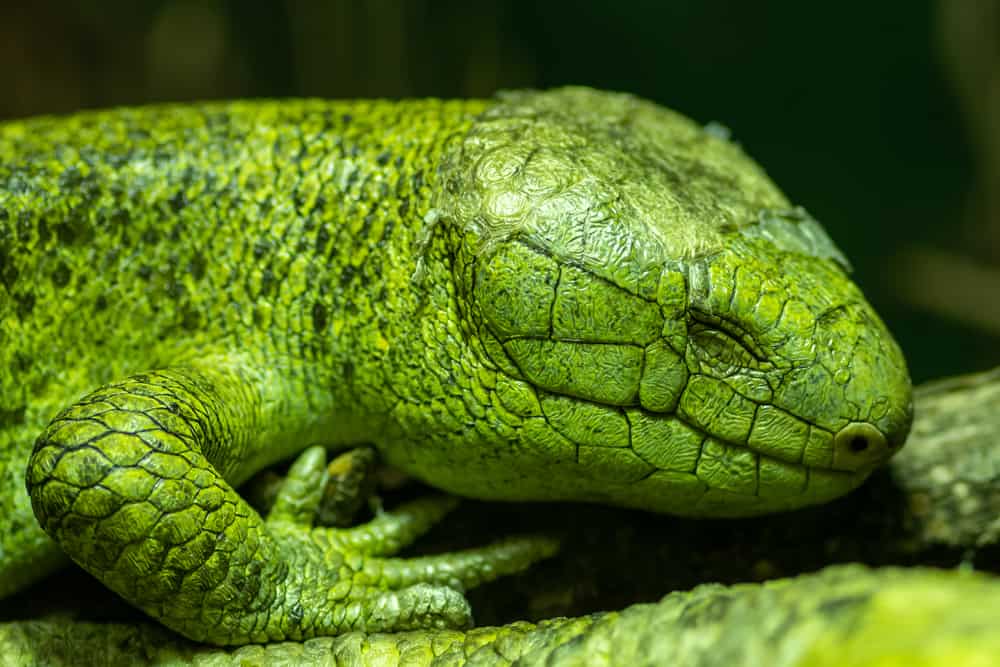
While some animals may become used to their owners, and even tolerate handling, most don’t like to fraternize with humans.
As we mentioned, they can come to recognize you, and will happily eat from your hand, but these skinks don’t enjoy being petted as much.
If you leave them alone, monkey-tailed skinks are aloof and won’t have much interest in you. Most of them tend to be reasonably docile, as long as you don’t try to touch them.
If you do try to pick them up, these lizards can be pretty spunky. They won’t hesitate to bite any part of you they can get to. They may also swipe at you with their claws.
All in all, the key to monkey-tailed skink temperament is this: respect their space, and they’ll respect yours.
Handling a Prehensile Tailed Skink
Most prehensile-tailed skinks aren’t too fond of handling. Some may learn to be okay with it, but most of them never do.
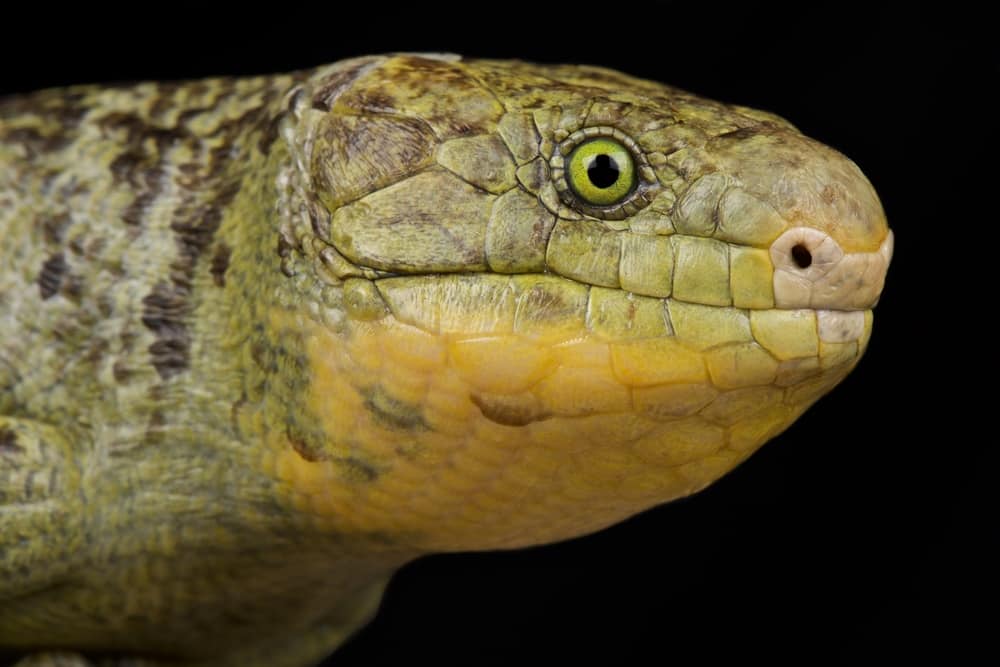
As mentioned earlier, these skinks live in trees. Their main predators in this habitat are birds, so never try to pick them up from above. If you do, they’ll think you’re a predator.
If you need to handle a Solomon Islands skink, here’s how to go about it:
- Approach the lizard from the side
- Take hold of its body behind the forelegs
- Lift it firmly but gently, and move it to the next location
- If you have a particularly docile skink, it may allow you to hold it, but this is a rare occurrence
Monkey Tailed Skink Lifespan
The monkey-tailed skink is the largest skink and has a lifespan to match.
Monkey-tailed skinks typically live for around 25 to 30 years. You can expect a minimum lifespan of 20 years. These animals are a long-term commitment.
Monkey-Tailed Skink Breeding
If you fall in love with these animals, it won’t be long before you want to make baby skinks.
Although their breeding method is somewhat unusual for a reptile, they’re not hard to breed.
Giant skinks are ovoviviparous.
In this breeding type, the females produce eggs, which they carry inside them until the babies hatch. The babies are born as live young, and the female expels the egg shell later.
That in itself isn’t extremely weird. Quite a few lizards have developed this breeding method since it means the young are born fully formed and capable of fending for themselves.
In the prehensile-tailed skink, the babies are massive: between one-third and one-half the size of the mother lizard.
To make up for this awkward arrangement, these skinks only produce one baby at a time. In rare cases, they may produce twins, but the babies will be slightly smaller than usual.
If you’re keeping a circulus of lizards, then breeding will happen as a matter of course.
If you’re keeping your lizards separately, you’ll need to keep them as a pair for a couple of weeks, then remove the female. These lizards can breed at any time of the year.
The gestation period for these skinks is six to eight months. When the mother nears the end of gestation, ensure that she has a safe-feeling hide where she can give birth.
If you’re keeping your skinks communally, give the female at least a month to recover before reintroducing her to the community.
Monkey Tailed Skinks Price
You can expect to pay over $1,300 for a hatchling monkey-tailed skink.
Thanks to their unique breeding arrangement (producing one baby at a time) breeders don’t produce many Solomon Islands skinks every year.
This results in a high-demand, low-availability situation where each animal fetches a high premium.
Depending on the breeder, you can expect to pay anything from $1,300 to $2,000 for a single hatchling. If you buy an adult, that value can easily double.
Where to Buy a Prehensile Tailed Skink
You could try a reptile convention, online reptile marketplace, or private breeder.
Whether you look for a monkey-tailed skink, prehensile skink, zebra skink, Solomons Island skink, or giant skink, breeders of these animals are easy to find.
That doesn’t mean that you’ll find a monkey-tailed skink easily, though.
These animals only produce one baby at a time (twins in rare cases) so they’re not easy to breed in large amounts.
The pet trade has seen considerably less Solomon Islands skinks since it became illegal to export wild-caught animals.
The best place to find Solomon Islands skinks for sale would be a reptile convention (Repticon) or reptile expo.
These events have hundreds of breeders from around the country. One of them is bound to have a monkey-tailed skink or to know a good breeder.
Another excellent option is asking on a reptile forum. Hobbyists tend to flock together, and if several people suggest a breeder you can probably trust them.
Since these animals produce only one baby at a time, you might end up on a waiting list.
Avoid buying a monkey-tailed skink from a pet store. Though exporting these lizards is illegal, there’s a lucrative smuggling trade and you can’t verify where the animal comes from.
Wild-caught animals are also more likely to suffer from intestinal parasites and other diseases common among lizards in the wild.
Are Solomon Islands Skinks Dangerous?
Zebra skinks aren’t deadly, but they’re mildly dangerous and can do some damage.
Unlike venomous species of reptile or large carnivores like alligators, prehensile-tailed skinks aren’t dangerous in a lethal way.
However, if you get in their space, monkey-tailed skinks will show their temper. They’ll attempt to run away at first but won’t hesitate to attack if you pursue them.
They have tiny, razor-sharp teeth for grinding up vegetables, and immensely strong jaws which they apply to pull chunks of foliage from plants.
They also have long claws which they use for climbing trees.
If they feel threatened, these lizards won’t hesitate to use one or both of these tools in their defense. At the very least, a bite from a giant skink will leave a bruise.
More often than not, they’ll leave a wound that draws a significant amount of blood.
These AREN’T appropriate pets for children, and you should treat them with respect. They won’t try to kill you, but they can hurt you.
Solomon Islands Skink Health
These skinks are relatively sturdy and don’t tend to get ill often. However, as with any reptile species, these animals can suffer health issues.
Metabolic Bone Disease (MBD)
Metabolic bone disease (MBD) is a serious problem in lizards and is caused by an incorrect ratio of calcium to phosphorus.
The symptoms of this disorder include:
- Limping
- Malformed limbs
- “Soft jaw” (an unusually soft and malleable lower jaw)
- Lack of appetite
- Difficulty moving
Animals with MBD don’t have enough Calcium during bone formation which leads to a weak skeletal structure.
Since their bones and tendons are weak, these animals suffer fractures and broken bones easily.
They also struggle to move normally, and often don’t have the body strength to move around much.
If caught early enough, you can reverse some of the damage caused by the calcium imbalance. It’s vital to bring the calcium intake up immediately, but not too high.
The best bet is to get your monkey skinks to a reptile vet as soon as possible. They’ll know which percentage of calcium the lizard needs to give it a shot at recovery.
This disease isn’t always reversible, and some animals might walk with a limp and have brittle bones for the rest of their lives.
That’s why it’s essential to use a high-quality calcium supplement from the beginning.
External Parasites
As with any reptile, the prehensile-tailed skink can suffer from several external parasites.
These parasites are most common in wild-caught animals or collections including wild-caught animals.
They may also pop up in collections with outdoor enclosures.
The most common external reptile parasites include:
- Mites
- Ticks
- Bot fly larvae
Parasites aren’t just annoying for the animals. They can spread disease and may eat parts of your skinks.
Ticks are easy to remove. Just grip the tick behind its head and pull slowly to remove the jaws from your skink’s scales.
The best way to treat mites is by using pesticides and medication. ALWAYS go to a vet for these products and an appropriate dosage.
It’s easy to kill your pets by mismanaging parasite treatments.
Bot fly larvae make a small chamber in the reptile’s skin, with a breathing hole.
You can remove them by carefully enlarging the breathing hole with forceps, and pulling out the larva.
If other fly larvae have made their home on your reptile, you need to pick off the maggots with forceps.
Then, look for the damaged skin (these maggots are attracted to exposed flesh and sores). Clean the sore with an antiseptic solution, and keep it clean.
It’s also good to take your skink to a vet, as they may think antibiotics are needed.
Intestinal Parasites
There are quite a few intestinal parasites that can inflict a monkey-tailed skink. The most common include pinworms and Coccidia.
Symptoms include:
- Eating a lot but not gaining weight
- Skinny animals
- Loss of appetite
- Lethargy
The most accurate way to find out if your skinks have internal parasites is to take a fresh stool sample to your vet for analysis.
However, there are other options. You can order a test kit online, which includes everything you need to do a basic parasite check.
Just order a test online. They’ll send you a test tube and a pre-stamped envelope. You place some of your skink’s dung in the tube, seal it in the envelope and send it off.
After testing, they’ll send you a comprehensive overview of any parasites the skink has. The best places may also give you a prescription for anti-parasitic drugs.
You can also send a stool sample for testing by an independent laboratory.
In most cases, you’ll need to get medication from a vet anyway, so taking your animal to a reptile vet is the easiest option.
Egg-binding
While monkey-tailed skinks give birth to live young, the young don’t develop as in mammals. Instead, the female retains the eggs inside her body, and they hatch before she “gives birth”.
She expels the egg’s shell from her body after the baby emerges. As with any egg-laying reptile, things can go wrong.
In some cases, the females may become egg-bound (also known as dystocia).
Females that are having a hard time giving birth will present with restless behavior, and wander all over the enclosure.
They may also strain visibly in their attempt to expel the baby. The cloaca (genital and digestive opening) becomes swollen.
If you don’t catch the situation early, it may worsen. Tissue may start hanging out of the cloaca, and the female might become lethargic and depressed.
If you think that your female skink is egg-bound, get them to a vet immediately.
The only way to confirm that the skink is full of eggs or young is by doing X-rays. They’ll also be able to tell you what to do to help your pet lizard.
Of course, it would be far better to avoid egg-binding entirely.
Ensure that your female skinks have a safe place to give birth, feed them a balanced diet, and ensure that they have room to get lots of exercise.
We hope you’ve enjoyed this article about monkey-tailed skinks. They’re remarkable pets if you can meet their unique needs.
If you’re still deciding what kind of pet lizard you want, we can help.
The pink-tongued skink is a much smaller, more beginner-friendly skink species to keep.
Check out our articles about the red-eyed crocodile skink, blue-tailed skink, and blue-tongued skink for smaller skink species that are more open to human interaction.
We also have an array of articles about bearded dragon care, including a bearded dragon vs. iguana comparison.
If none of those strike your fancy, check out our article about the best pet lizards.
Are you planning on getting a monkey-tailed skink, or some other lizard? Let us know in the comments.
